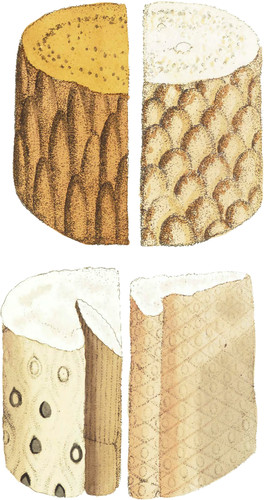 Enlarge
Enlarge
British Mineralogy
Siliceous Standstone
- Class 2. Earths.
- Ord. 3. Aggregated.
- Gen. 6. Silex.
- Spec. 2. Grains of Silex more or less agglutinated.
- Div. 3. Amorphous
- Spec. Char. Fracture granular.
- Syn.
- Siliceous sandstones. Kirw. v. 1. 364.
- Cos fraibilis. Linn. Syst. v. 3. p. 63. 9.
- — coagmentata. Linn. Syst. v. 3. p. 63. 10.
- Quartz aranacée agglutinée, ou Grés. Haüy, v. 4. 464.
Sandstones may be said to be composed chiefly of quartz in smaller or larger particles, which, according to Kirwan, should not exceed one third of an inch in diameter. In the representation of such as are not primitive sandstones, it is though of much utility to put those which have impressions on their surfaces of plants, shells, or other things formerly organized, that while we acquire a common idea of the substance, it may help geological purposes, which will be found extremely essential in mineralogy, as it leads to the æra of formation of different strata, distinguishing by such helps the more recent from the most remote.
The lower figures in this plate are of the finest texture: the particles in the right hand figure are so fine as scarcely to be discerned without a magnifying glass: the fracture, which is a little shattery as well as earthy, in some parts readily shows the sand-like texture. It is more strongly cemented in other parts by means of a very little lime, and more strongly still by a siliceous cement. The original of the impression we do not at present know. The particles in the left hand figure are somewhat larger, but are more compactly agglutinated by the siliceous cement, and seem as if more or less fused into each other, somewhat approaching the vitreous appearance. The impression seems to belong to some vegetable, possibly furnished with spines in the order where the little ovate knobs appear, which in a specimen lent me by Sir Joseph Banks were rounder, his whole specimen not being compressed*. The upper figure with the long squamæ is what is called by Kirwan ferruginous Sandstone, see v. 1. p. 365. It is coloured with an oxide of iron, which seems to be in that state of oxygenization on the outside, which has the conglutinating powr ascribed to it by Mr. Kirwan, and is consequently more compact on the outside than on the inside. Pebble stones held together in this manner are very common in gravelly places about London.
The right hand upper figure is a coarser stone of a similar nature, with some pebbles occasionally here and there about it; also some lumps of a chalky appearance resembling decomposing feltspar, if I may guess by the little remains of the crystal and fracture. Thus it is perhaps next in order to the rubble stone of Kirw. v. 1. 366. Sandstones are found in many parts of England, and are of great use. They are natural filters in the laboratory of nature, and are now become a modern branch of traffic in Derbyshire, London, and other places, for filtering water. They are brought from Newcastle for grindstones, sharpening of scythes, rubbing down copperplates, &c. Some sorts have been used for buildings, as at Windsor Castle, which is chiefly of the whiter kind and fine grained. They grey and black blotches will be explained hereafter. Mr. Martyn above mentioned has given figures of several specimens of these in his Derbyshire Petrifactions.
- * I have figured the specimen given me by Mr. Martin of Derbyshire as it had an impression on it resembling a bamboo stalk, although Sir Joseph Banks’s was better in other respects.

